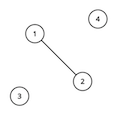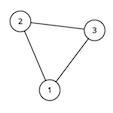CodeForces 744A Hongcow Builds A Nation (并查集)
2016-12-23 20:24
459 查看
Hongcow Builds A Nation
time limit per test
2 seconds
memory limit per test
256 megabytes
input
standard input
output
standard output
Hongcow is ruler of the world. As ruler of the world, he wants to make it easier for people to travel by road within their own countries.
The world can be modeled as an undirected graph with n nodes and m edges. k of
the nodes are home to the governments of the kcountries that make up the world.
There is at most one edge connecting any two nodes and no edge connects a node to itself. Furthermore, for any two nodes corresponding to governments, there is no path between those two nodes.
Any graph that satisfies all of these conditions is stable.
Hongcow wants to add as many edges as possible to the graph while keeping it stable. Determine the maximum number of edges Hongcow can add.
Input
The first line of input will contain three integers n, m and k (1 ≤ n ≤ 1 000, 0 ≤ m ≤ 100 000, 1 ≤ k ≤ n) —
the number of vertices and edges in the graph, and the number of vertices that are homes of the government.
The next line of input will contain k integers c1, c2, ..., ck (1 ≤ ci ≤ n).
These integers will be pairwise distinct and denote the nodes that are home to the governments in this world.
The following m lines of input will contain two integers ui and vi (1 ≤ ui, vi ≤ n).
This denotes an undirected edge between nodes ui and vi.
It is guaranteed that the graph described by the input is stable.
Output
Output a single integer, the maximum number of edges Hongcow can add to the graph while keeping it stable.
Examples
input
output
input
output
Note
For the first sample test, the graph looks like this:

Vertices 1 and 3 are special.
The optimal solution is to connect vertex 4 to vertices 1 and 2.
This adds a total of 2 edges. We cannot add any more edges, since vertices 1 and 3 cannot
have any path between them.
For the second sample test, the graph looks like this:

We cannot add any more edges to this graph. Note that we are not allowed to add self-loops, and the graph must be simple.
题意:在一个星球上,有n个点,m条边,其中有k个点是不同国家的政府。 要求结点没有到自己的边,任意两个结点间只存在一条边,任意两个政府点之间不存在路径。 问满足上面三个条件下,最多往图中添加几条边。
思路:先利用并查集求得每个树上的点数,下面分三种情况
1.每棵树上可以添加的边数 (ran[i]*ran[i]-1)/2;
2.没有限制的两棵树之间可以相互进行连接;
3.对于有限制的树,找到有限制的树中点数最多的树,将它与没限制的树进行连接。
最后要减去已经连过的m;
time limit per test
2 seconds
memory limit per test
256 megabytes
input
standard input
output
standard output
Hongcow is ruler of the world. As ruler of the world, he wants to make it easier for people to travel by road within their own countries.
The world can be modeled as an undirected graph with n nodes and m edges. k of
the nodes are home to the governments of the kcountries that make up the world.
There is at most one edge connecting any two nodes and no edge connects a node to itself. Furthermore, for any two nodes corresponding to governments, there is no path between those two nodes.
Any graph that satisfies all of these conditions is stable.
Hongcow wants to add as many edges as possible to the graph while keeping it stable. Determine the maximum number of edges Hongcow can add.
Input
The first line of input will contain three integers n, m and k (1 ≤ n ≤ 1 000, 0 ≤ m ≤ 100 000, 1 ≤ k ≤ n) —
the number of vertices and edges in the graph, and the number of vertices that are homes of the government.
The next line of input will contain k integers c1, c2, ..., ck (1 ≤ ci ≤ n).
These integers will be pairwise distinct and denote the nodes that are home to the governments in this world.
The following m lines of input will contain two integers ui and vi (1 ≤ ui, vi ≤ n).
This denotes an undirected edge between nodes ui and vi.
It is guaranteed that the graph described by the input is stable.
Output
Output a single integer, the maximum number of edges Hongcow can add to the graph while keeping it stable.
Examples
input
4 1 2 1 3 1 2
output
2
input
3 3 1
21 21 3
2 3
output
0
Note
For the first sample test, the graph looks like this:

Vertices 1 and 3 are special.
The optimal solution is to connect vertex 4 to vertices 1 and 2.
This adds a total of 2 edges. We cannot add any more edges, since vertices 1 and 3 cannot
have any path between them.
For the second sample test, the graph looks like this:

We cannot add any more edges to this graph. Note that we are not allowed to add self-loops, and the graph must be simple.
题意:在一个星球上,有n个点,m条边,其中有k个点是不同国家的政府。 要求结点没有到自己的边,任意两个结点间只存在一条边,任意两个政府点之间不存在路径。 问满足上面三个条件下,最多往图中添加几条边。
思路:先利用并查集求得每个树上的点数,下面分三种情况
1.每棵树上可以添加的边数 (ran[i]*ran[i]-1)/2;
2.没有限制的两棵树之间可以相互进行连接;
3.对于有限制的树,找到有限制的树中点数最多的树,将它与没限制的树进行连接。
最后要减去已经连过的m;
#include<stdio.h>
#include<string.h>
#include<algorithm>
#include<vector>
using namespace std;
vector<int>mp;
int pre[1100],ran[1100];
int find(int x)
{
if(x==pre[x])
return x;
return pre[x]=find(pre[x]);
}
void merge(int x,int y)
{
int fx=find(x);
int fy=find(y);
if(fx!=fy)
{
pre[fx]=fy;
ran[fy]+=ran[fx];
}
}
int n,m,k,i,j,a,b,c[1100],gov[1100];
int main()
{
while(scanf("%d%d%d",&n,&m,&k)!=EOF)
{
for(i = 0; i <= n; i++)
{
pre[i] = i;
ran[i] = 1;
gov[i]=0;
}
for(i=0;i<k;i++)
{
scanf("%d",&c[i]);
}
for(i = 0; i < m; i++)
{
scanf("%d%d",&a,&b);
merge(a,b);
}
for(i = 0; i < k; i++)
{
gov[find(c[i])]=1;//标记受限制的点
}
int sum = 0,maxx = 0;
for(i = 1; i <= n; i++)
{
if(find(i)==i)
{
if(gov[i])//找到受限制的块中,点数最多的块
{
maxx = max(ran[i] , maxx);
}
else
{
mp.push_back(ran[i]);
}
sum += ran[i]*(ran[i]-1)/2;//每一个块中可以连接的边数
}
}
for(i = 0; i < mp.size(); i++)
{
for(j = i+1; j<mp.size(); j++)
{
sum +=mp[i]*mp[j];//没有限制的块,两两之间进行连接
}
sum+=mp[i]*maxx;//没有限制的块与点数最多的有限制的块连接
}
printf("%d\n",sum-m);//减去已经连接的m条边
}
return 0;
}
相关文章推荐
- Codeforces 896E Welcome home, Chtholly 分块+并查集
- CodeForces - 566D Restructuring Company(并查集记录区间边界)
- CodeForces - 731C Socks(并查集)(贪心)
- 【打CF,学算法——四星级】CodeForces 455C Civilization (【详解】并查集+树的直径)
- Codeforces 292 D. Connected Components (并查集)
- codeforces 731C (并查集 水)
- CodeForces - 698B Fix a Tree(并查集)
- CodeForces - 859E Desk Disorder 思维 + 并查集判环
- Codeforces 939D Love Rescue(并查集)
- Codeforces 699D Fix a Tree 并查集
- CodeForces 731C C - Socks 并查集
- Codeforces 776D The Door Problem 【并查集】
- codeforces 468B Two Sets 并查集
- codeforces 731c Socks 并查集
- Codeforces 893C Rumor (并查集)
- Codeforces 278C Learning Languages(并查集)
- CodeForces - 480E-DP+并查集
- Codeforces 506D Mr. Kitayuta's Colorful Graph 并查集+水水的分类讨论+水水的离线预处理
- Codeforces 811E Vladik and Entertaining Flags[线段树][并查集]
- CodeForces 217A Ice Skating(并查集思路)
